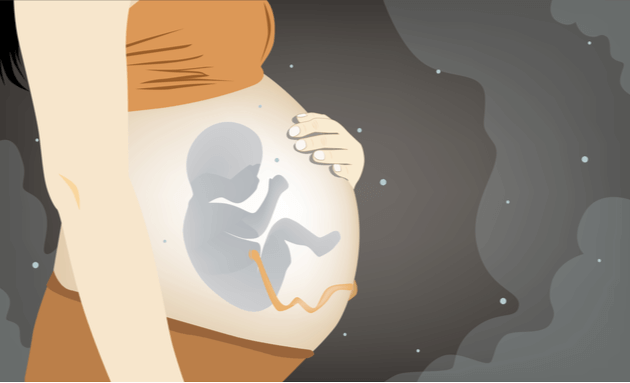In a ground-breaking revelation, a new study uncovers the profound impact of air pollution on pregnant women and their unborn children. While air pollution has long been recognized as a health hazard, its potential to influence the intricate processes of pregnancy and fetal development demands urgent attention. This study, published in Science Advances, dives deep into the biological mechanisms, shedding light on how fine particulate matter, specifically PM2.5, alters immune responses and sets the stage for adverse pregnancy outcomes.
Pregnant women navigate a delicate balance of physical and emotional well-being, ensuring their bodies provide the safest environment for their babies. However, the quality of the air they breathe may silently sabotage their efforts. PM2.5, or fine particulate matter, is an airborne pollutant so small it can easily infiltrate the lungs and enter the bloodstream. Unlike other environmental threats, PM2.5 is invisible to the naked eye, making it particularly insidious.
PM2.5 particles, measuring less than 2.5 micrometers in diameter, are produced by vehicle emissions, industrial activities, wildfires, and even household cooking. These particles carry toxic substances that, when inhaled, can cause oxidative stress and inflammation in the body. While previous studies have linked PM2.5 exposure to respiratory and cardiovascular diseases, the recent focus on its effects during pregnancy reveals an even more concerning narrative.
Researchers at Harvard T.H. Chan School of Public Health conducted an innovative study to explore PM2.5’s impact at a cellular level. Using advanced single-cell analysis, they examined how air pollution influences the DNA of individual cells in both non-pregnant women and those 20 weeks into pregnancy. The findings were startling.
The study mapped changes in histones—proteins critical to DNA structure and gene regulation—within cells exposed to PM2.5. These histone modifications disrupted the normal balance of cytokine genes, which regulate inflammation in the body. For pregnant women, this imbalance resulted in heightened inflammation, a state known to be detrimental to both maternal and fetal health.
Inflammation is a double-edged sword during pregnancy. While some degree of inflammatory response is necessary for implantation and labour, excessive inflammation can lead to complications. The study identified a direct link between PM2.5 exposure and increased inflammatory markers in pregnant women.
For expecting mothers, this heightened inflammation can manifest in various ways:
1. Preeclampsia: A condition characterized by high blood pressure and organ damage.
2. Low Birth Weight: Babies born underweight are at higher risk of developmental and health issues.
3. Developmental Delays: Early childhood may be marred by cognitive and physical challenges.
Fetal development is an intricate process where every cell division and gene expression matters. The Harvard study revealed that PM2.5-induced inflammation doesn’t stop at the mother; it crosses the placenta, influencing the developing fetus. Increased cytokine levels in the fetus can disrupt organ formation, immune system development, and even brain function.
This research marks a pivotal moment in understanding how environmental factors shape human health. The study goes beyond statistical associations and dives into biological pathways, providing a clearer picture of how PM2.5 exposure can directly affect pregnancies.
Professor Kari Nadeau, a leading voice in the study, emphasized its significance: This represents a substantial step forward in understanding the biological pathways by which PM2.5 exposure affects pregnancy, maternal health, and fetal development.
The innovative methodologies used in this research also pave the way for more precise investigations into how environmental exposures impact human biology.
The findings highlight the urgent need for measures to protect pregnant women from air pollution. Here’s what can be done:
Governments and regulatory bodies must prioritize improving air quality. Stricter emissions controls, cleaner energy sources, and urban planning strategies to reduce pollution hotspots can make a significant difference.
Healthcare providers should play an active role in educating pregnant women about the risks of air pollution and offering practical advice, such as:
- Avoiding high-pollution areas: Minimizing time spent outdoors during peak pollution hours.
- Using air purifiers: Creating a cleaner indoor environment.
- Wearing protective masks: Particularly in urban areas with high traffic pollution.
While systemic change takes time, individuals can take immediate steps to reduce exposure:
- Monitoring air quality: Using apps and alerts to plan outdoor activities.
- Switching to cleaner energy sources: Reducing reliance on wood-burning stoves or coal.
Air pollution is a global issue that transcends borders and socioeconomic divides. Pregnant women and their unborn children represent a vulnerable population, but they are not alone in facing the consequences of polluted air. The health impacts of PM2.5 ripple through communities, affecting children’s growth, adults’ productivity, and the elderly’s longevity.
To truly address the problem, societies must embrace sustainability. Reducing reliance on fossil fuels, adopting greener technologies, and fostering a culture of environmental stewardship are not just lofty goals, they are necessities.
While the findings of this study are alarming, they also offer a glimmer of hope. By identifying the biological pathways affected by PM2.5, researchers have opened the door to potential interventions. Future studies could focus on developing therapies or preventive measures to counteract the inflammatory effects of air pollution during pregnancy.
Pregnancy is a journey of hope and anticipation. While the risks posed by air pollution are real, knowledge is a powerful tool. By staying informed and taking proactive steps, mothers can navigate these challenges and give their babies the best possible start in life.
The air we breathe should nurture life, not worsen it. This study is a wake-up call to governments, healthcare providers, and individuals alike. Protecting pregnant women from the harmful effects of PM2.5 isn’t just about safeguarding one generation, it’s about shaping a healthier, more resilient future for all.
As we strive for cleaner air and healthier communities, the responsibility lies with each of us to advocate for change. Because every breath matters, especially when it’s shared with the next generation.
http://www.21stcenturyhospitalgownplus.com/
http://www.elite-factory-15.fr/
http://www.gba-amateurboxen.de/
http://www.kita-strausberg.de/
http://sonispicehelensburgh.co.uk/
http://curryzonecardonald.co.uk/
http://cinnamon-edinburgh.co.uk/
http://www.bombaydelipaisley.com/
http://pizzanightclydebank.co.uk/
http://www.pizzanightclydebank.com/
http://gyros2goclydebank.co.uk/
http://grillicious-glasgow.co.uk/
http://www.abdulstakeaway.com/
http://www.freddiesfoodclub.com/
http://cinnamonportobello.co.uk/
http://www.romafishnchips.com/
http://bombaydelipaisley.co.uk/
http://yaraloungerestaurant.co.uk/
http://tasteofchinacoatbridge.co.uk/
http://www.memoriesofindiagorebridge.com/
http://memoriesofindiaeh23.co.uk/
http://freddiesknightswood.co.uk/
http://gyros2gohardgate.co.uk/
http://www.strausseeschwimmen.de/
http://www.janstanislawwojciechowski.pl/
http://london-takeaways.co.uk/
http://shahimanziledinburgh.co.uk/
http://freddiesfoodclub.co.uk/
http://www.spicestakeaway.com/
http://www.mexita-paisley.com/
http://pandahouseglasgow.co.uk/
http://www.zum-alten-steuerhaus.de/
http://www.oberstufenzentrum-mol.org/
http://www.morsteins-neuenhagen.de/
http://www.maerkische-jugendweihe.de/
http://www.planungsbuero-henschel.de/
http://www.hertzelektronik.de/
http://www.militaergefaengnisschwedt.de/
http://www.fahrrad-naumann.de/
http://www.hondamoto-villemomble.com/
http://www.hondamoto-royan.com/
http://www.hondamoto-ajaccio.com/
http://www.download-skycs.com/
http://www.sisakoskameleon.hu/
http://www.hondamoto-montauban.com/
http://www.hondamoto-chalonsursaone.com/
http://www.hondamoto-champignysurmarne.com/
http://www.hondamoto-asnieres.com/
http://www.pasquier-motos.com/
http://www.evacollegeofayurved.com/
http://www.compro-oro-italia.it/
http://www.hondamoto-saintmaximin.com/
http://www.hoangminhceramics.com/
http://www.pasiekaambrozja.pl/
http://www.xn--b1alildct.xn--p1ai/
http://www.ferreteriaflorencia.com/
http://www.thevichotelkisumu.com/
http://www.nexuscollection.com/
http://www.moitruongminhhuy.com/
http://www.ozkayalarpaslanmaz.com/
http://www.munkagepmonitor.hu/
http://www.my247webhosting.com/
http://www.thesmokingribs.com/
http://www.healthlabgrosseto.it/
http://www.ochranakaroserie.cz/
http://www.phukiendonginox.com/
http://www.meijersautomotive.nl/
http://www.kartaestudentit.al/
http://www.podlahyjihlavsko.cz/
http://www.hillhouseequestrian.com/
http://www.gradskapivnicacitadela.com/
http://www.capella-amadeus.de/
http://www.landfleischerei-auris.de/
http://www.faistesvacances.be/
http://www.autoservice-doernbrack.de/
http://www.tabakhaus-durek.de/
http://www.oldtimer-strausberg.de/
http://www.imexsocarauctions.com/
http://www.kaslikworkshop.com/
http://www.firefightercpr.com/
http://www.visuallearningsys.com/
http://www.hanksautowreckers.com/
http://www.impresospichardo.com/
http://www.philiphydraulics.net/
http://www.internationaldentalimplantassociation.com/
http://www.indywoodtalenthunt.com/
http://www.badicecreamgame.com/
http://www.riad-amarrakech.com/
http://www.centrodeformacioncanario.com/
http://www.socialdefender.com/
http://www.pepiniere-paravegetal.com/
http://www.reparertelephonearles.fr/
http://www.namsontrongdoi.com/
http://www.devipujakjivansathiseva.in/
http://www.laymissionhelpers.org/
http://www.vangiaphatdeco.com/
http://www.isscoachinglucknow.in/
http://www.hieuchuandoluong.com/
http://www.aurorabienesraices.com/
http://www.indianmoversassociation.com/
http://www.oztopraklarotomotiv.com/
http://moitruongnamnhat.com.vn/
http://www.dienmayvinhthuan.vn/
http://www.divadelkoproskoly.cz/
http://www.xn--12cfje1df4hdl7f1bf2evg9e.com/
http://www.westernirontrailers.com/
http://www.jazzaufildeloise.fr/
http://www.signcraft-drone.com/
http://www.realtyhighvision.com/
http://www.thermexscandinavia.nl/
http://imobiliariafelipe.com.br/
http://www.salon-lindenoase.de/
http://www.jezirka-zahrada.cz/
http://www.singhanialogistics.in/
http://www.der-pixelmischer.de/
http://www.hegermuehlen-grundschule.de/
http://www.radiologie-strausberg.de/
http://www.foto-studio-matte.de/
http://www.tables-multiplication.com/
http://www.rusztowania-belchatow.pl/
http://www.fishingandhuntingheaven.com/
http://www.orologiegioiellilameridiana.it/
http://www.rotarybresciaest.org/
http://www.jacarandaspain.com/
http://www.javieririberri.com/
http://www.huebelschraenzer.ch/
http://www.illinoiscreditunionjobs.com/
http://www.iznikdenizorganizasyon.com/
http://www.leasebackconcierge.com/
http://www.eoisantacoloma.org/
http://skullbasesurgery.co.uk/
http://www.immobilienplattensee.com/
http://www.germandailynews.com/
http://www.gptdcinternational.com/
http://www.forklifttrainingedmonton.com/
http://www.kashiwanakayama-cl.com/
http://www.thehousemediagroup.com/
http://www.pensiimaramures.ro/
http://www.michaelakokesova.cz/
http://www.viswabrahmanaeducationaltrust.com/
http://krone-aluminium.com.pl/
http://www.broadwaylumber.com/
http://www.ambulancesoccasions.com/
http://www.continuumintegrated.com/
http://www.joilifemarketing.com/
http://www.rotaseydisehir.com/

 The air we breathe should nurture life, not worsen it. This study is a wake-up call to governments, healthcare providers, and individuals alike
The air we breathe should nurture life, not worsen it. This study is a wake-up call to governments, healthcare providers, and individuals alike










.jpeg)

.jpeg)
.jpeg)
.jpeg)

.jpeg)
.jpeg)
.jpeg)
_(1).jpeg)

_(1)_(1)_(1).jpeg)
.jpeg)
.jpeg)
.jpeg)






